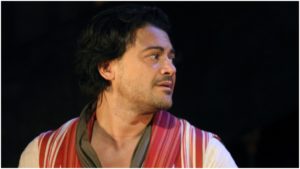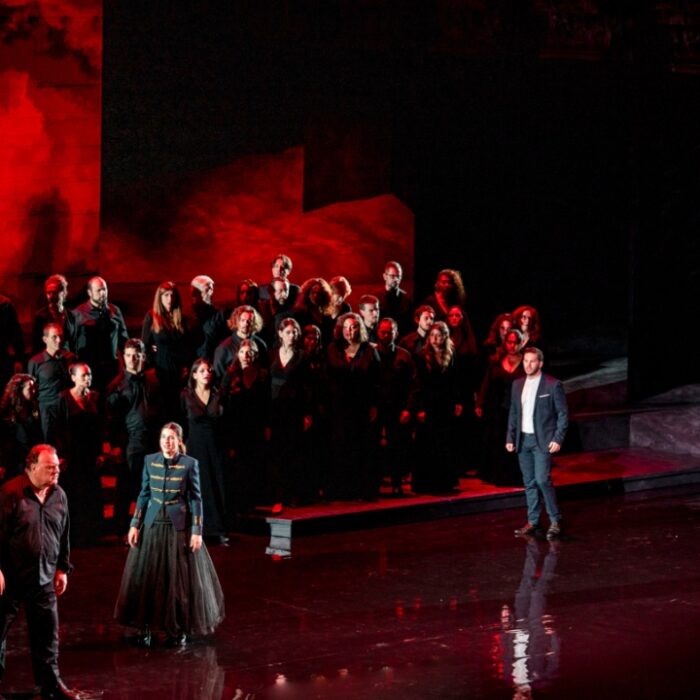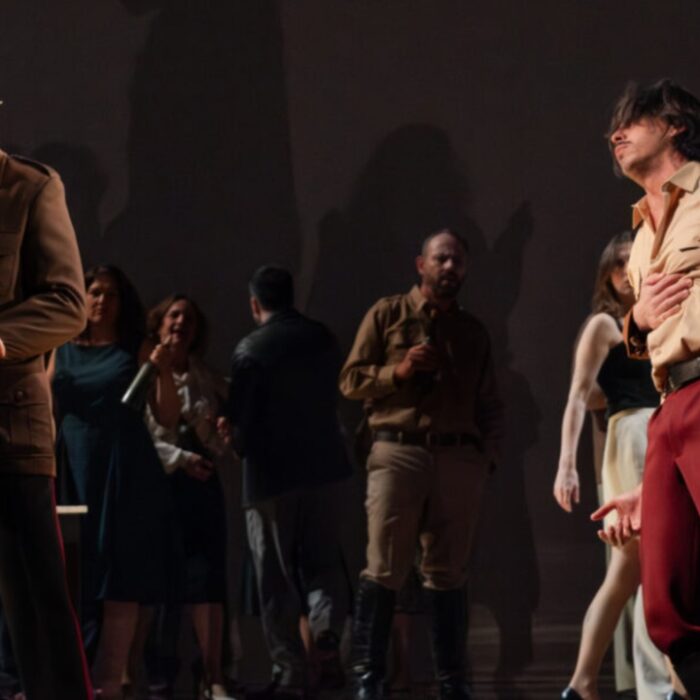
Royal Opera 2018-19 Review: Tosca
Gheorghiu & Grigòlo’s Interpretations are Threadbare in this Worn-Out Revival
By Sophia Lambton(Credit: Catherine Ashmore / Royal Opera House)
At the tender age of 12, Jonathan Kent’s 2004 production of Tosca is among the fledglings of the Royal Opera roster. Visually simplistic and at times homogeneous, it eschews the archetypical velvet red and gleaming gold numerous incarnations of the opera take in favor of a dusky navy that enrobes the Sant’Andrea church, the Palazzo Farnese and the irrepressibly starry sky to which Cavaradossi devotes his last aria. Speckles of glimmering light fracture darkness only through the golden gate and icon both aglitter in the church, and later on in the embroidery of Tosca’s pearl-white gown and loops of her tiara.
The spectacle is no source of displeasure to the eye – if somewhat elementary in its need to color-code the purity of light in both the heroine of Tosca and the pastel shades in Angelotti’s painting of the inappropriately envied, Madonna-like Marchesa Attavanti. Nevertheless, given the lavish worlds in which both heroine and villain each reside – be it the glamour of a 19th-century prima donna’s life or Scarpia’s unearned luxury as a dictator – the audience is left in want of intricate adornments and a coat of opulence.
Smothering the Role
Immersing herself in an oft-played creation, Angela Gheorghiu smothers the role in an overplayed, overwrought characterization. While the luster in her middle register traverses scales and ornaments with ease in mezzo forte, notes above are frequently subjected to sudden, affected piano, near-cracks or a facile substitution of “parlato:” spoken rather than sung text. Tosca’s demand to know “Chi è quella donna bionda lassù?” should be sung, but in this instance sounds more like a yell.
Other phrases in the work call for the usage of “parlato” – most notably Tosca’s realization after her murder of Chief Scarpia, “E avanti a lui… tremava tutta Roma.” But rather than make this the introspective reflection of a woman cold with shock from her impulsive and yet indispensable action, Gheorghiu twists this spoken phrase into a high-pitched, neigh-like exclamation of long vowels and several dozen syllables. Instead of reflecting on the nefarious ramifications of what is, in this Roman Republic, an act of treason, Gheorghiu’s Tosca lets the fictional singer’s poor operatic acting abilities rear their Gorgonian heads: killing for Tosca is just another feat worthy of an audience’s standing ovation.
The beloved “Vissi d’arte” is here treated as it may have been during “Tosca’s” inception in 1900, assuming the guise of a vehicle for insouciant, excessive and at times hammy artistic expression. That E-flat of “vi” is a little off-pitch, and not squarely hit but slid up to; “aiutai” – Tosca’s profession that she allayed others’ misfortunes – is met with extra affectation and a surplus of diminuendo before drifting off into the ether. By the time Tosca’s referencing the flowers she deposited at the altar (“diedi fiori agl’altar”), the voice breaks off and briefly no emission can be heard. With Gheorghiu’s passaggio being for the most part secure, it is a shame that pivotal, climactic moments in their overworked state almost veer towards extinction.
The Zeal of Demonstration
Vittorio Grigòlo doesn’t spare the unabashed, declamatory outpour of his robust tenor voice to forge a scarlet-blooded Mario Cavaradossi: his is a bold interpretation riddled by the zeal of demonstration. “Recondita armonia” – the “hidden harmonies” that Cavaradossi uses to paint the Marchesa Attavanti – is embarked on with unstoppable panache in quivering, overstretched notes.
Cavaradossi may be a proud painter, but Grigòlo enhances the character’s bombasticity to the exclusion of his evident tenderness. Anxious about prisoner Angelotti’s escape, Cavaradossi requests that Tosca “lasciami al lavoro.” Even the libretto concedes that despite Tosca’s manifest coquetry, his thoughts are elsewhere. Grigòlo nevertheless interprets “elsewhere” at times to mean he has no interest in this woman, persuading one to wonder how a famous singer of her clout could fall for somebody hard-pressed to cast a second glance in her direction. By the time he has reached “E lucevan le stelle”, Cavaradossi’s admission “l’ora è fuggita” is met with such excessive vibrato that it sounds at times as though the notes purport to shift onto another line.
Most of Out Of Character
Perhaps most out of character is Marco Vratogna’s excessively reflective Scarpia. Missing the reckless swagger of the burly and repulsive beast, Vratogna fashions his Scarpia maybe a little too much as a “misunderstood” individual, accentuating the aging man’s fragility with extra breaths and soft diminuendos that fall short of manifesting his coarse physicality.
Scarcely are we invited to see that Scarpia is overbearing, unsparing and completely at the mercy of his zealous hate; instead, his declaration in the “Te Deum” of “Nel tuo cor s’innida Scarpia” – resounds in modesty as just an airy afterthought.
Alexander Joel’s conducting aptly incorporates Puccini’s abrupt starts and stops into its feisty execution of the score – but often to their detriment. A flaring crescendo during the introduction of Act Three’s “E Lucevan Le Stelle” motif is as outrightly expositional as Gheorghiu’s Statue of Liberty-like lifted arm before Tosca’s fatal last plunge. Brass are almost infallibly muffled with select raspberries being blown here and there; at times the strings are so disheveled that the pitch of notes becomes a struggle for the ears to recognize.
Next to the other members of their struggling troupe both Michael Mofidian’s Angelotti and Jonathan Lemalu’s Sacristan offer considerable reinforcements by sculpting their much smaller roles with better vocal proportions and overall far more realism.
Their carefulness however cannot compensate for the production’s omnipresent cartoon-like interpretations which, for whatever reason, spearhead this “Tosca” back into the genre’s dark ages: when acting was a superimposition never to be integrated into a performance.
It’s a journey on a time machine the audience is ill-advised to undertake.



